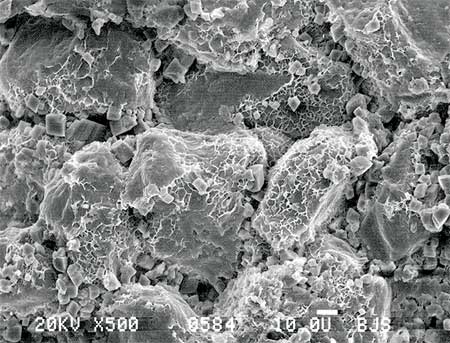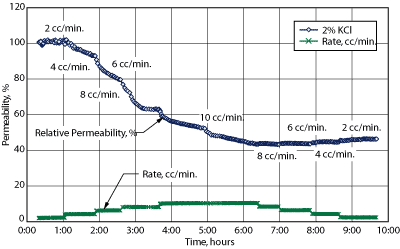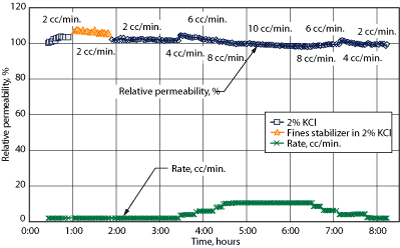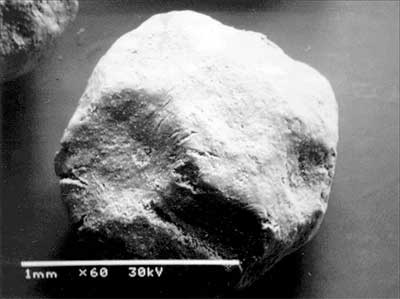SAND CONTROL
Keeping fines in their place to maximize inflow
performance
Immobilizing
formation fines and enhancing proppant properties keeps formation
pore throats, gravel packs and screens clear for hydrocarbon production.
Andy Jordan and Bruce
Comeaux, BJ Services
Producing hydrocarbons is by definition disruptive; drilling, completion
and production processes upset the equilibrium within a reservoir rock
matrix that has formed over hundreds of millions of years. Many of
the disruptions impair formation inflow performance, resulting in sub-optimal
production.
Prevention is better than cure: The industry is constantly searching
for methods to eliminate expensive remedial operations, such as through-tubing
completion repairs or full-scale rig re-completions. A variety of new
technologies have been developed for implementation during the initial
completion to combat problems associated with fines migration.
Clay fines and their swelling and migration are routinely treated
with clay stabilizers; however, non-clay fines and potential proppant
failure/plugging are often ignored in completion and stimulation planning.
Fit-for-purpose, engineered solutions can minimize inflow performance
reduction caused by fines generation, fines migration, plugging of
the rock matrix, proppant pack or screens. Depending on formation characteristics,
system components might include additives such as fines-stabilization
agents, proppant enhancement materials and/or resin-coated proppants.
FINES MIGRATION
Due to their weak nature, most unconsolidated sandstone formations
require some type of solids production control. Well screens, often
combined with gravel packs or frac-pack treatments, are routine solutions.
Many unconsolidated sandstone reservoirs are also associated with
steeper-than-normal production decline due to fines migration. In these
formations, fines are typically very loosely bound to the reservoir
sand grains. When mobilized, fines may plug the pore throats of the
formation, gravel or well screen, Fig. 1.
 |
Fig.
1. A scanning electron microscope image shows
fines on the formation matrix; chemical and mechanical
effects cause the fines to migrate, blocking pore throats
and reducing permeability and production. |
|
This phenomenon has been reported in most of the geographical areas
where these rock types are prevalent, especially the Gulf of Mexico,
California, the North Sea, the west coast of Africa and Venezuela.
Some mineralogical studies in the more recent development areas in
India, China and other Asia-Pacific basins also indicate the potential
for fines migration.
Mineralogical studies can readily identify
a specific formation’s
potential for fines migration. Problematic migrating siliceous fines
are defined as sub-44-µm solid particles, with further categorization
by size (colloidal fines being particles smaller than 2 µm) and
by composition (clay materials and non-clay fines such as quartz, feldspar
and mica).
Depending upon their size and composition, fines can be mobilized
in a variety of ways, generally divided into chemical and mechanical
phenomena. Chemical effects weaken the bonds between the fines and
the rock matrix. Mechanical effects relate to the drag forces on the
particles due to fluid flow within the matrix. Mechanical effects may
also be exacerbated due to changes in downhole stresses during production.
Although the mechanism is not totally understood, fines may actually
be generated during the completion process as a result of fluid infiltration
into the formation. As native reservoir fluids are displaced with completion
fluid filtrate, the chemical environment changes, weakening the forces
bonding the fines to the matrix. Simultaneously, mechanical forces
are introduced as the filtrate flows though the matrix. The velocity
and drag forces of the filtrate forced through the rock pores during
the sand control/frac pack process are typically an order of magnitude
greater than the flow rate during subsequent production. But in many
cases drag forces from production alone can be sufficient to cause
fines migration, particularly when associated with increasing water
breakthrough.
In addition, it has been well-documented that acid stimulation treatments,
if not properly engineered, by their nature may release large quantities
of fines. Clay stabilization additives are used to minimize potential
damage, but when non-clay fines are present, plugging damage from migrating
fines is often observed. Fines stabilization additives have long been
used to combat this problem.
One particularly successful fines stabilization
option has been a Hydrolysable Organosilane Complex (HOC) that forms
a non-oil-wetting polysiloxane coating to “link” (by
a covalent bond) siliceous particles (clay and non-clay grains and
fines), thereby immobilizing small particles. Importantly, the short-chain
polysiloxanes do not adversely affect permeability.
ACID TREATMENTS
In a typical acid stimulation example, after treating a well in Bolivia
in 2003, the operator recorded four-fold production with a 1/2-in.
choke, but the decline rate was high because the Petaca formation was
producing fines. Re-stimulating the well with acid and 5 gpt of the
fines stabilizer dropped the decline rate and extended continuous production
for several months. In a second Petaca formation well, the acid treatment
quadrupled the production from 90 to more than 400 bopd, with production
continuing at 300 bopd some 70 days later.
In the Gulf of Mexico, a 2003 field-wide
study of historical production in a mature field determined that
fines migration was significantly contributing to field-wide production
declines and the inability to sustain production increases after
acid stimulations. The acid treatments were re-engineered using the
(clay) fines stabilizer and some acid stimulation best practices
(comprising afterflush and preflush of a CO2 preflush stage, and
optimizing the mix of hydrofluoric and hydrochloric acid in the main
stage). The result was increased long-term (>10
months in some cases) oil production in the field by more than 150
bopd per well.
Although it has not been quantified how much each design change affected
the overall improved outcome, rather than trying to determine which
particular re-engineered procedure had the greatest effect, the operator
simply continued to apply all of the changes in the stimulation program
on each well.
These and other similar acid stimulation experiences suggested that
HOCs might be useful for fines stabilization in other problem areas.
LABORATORY TESTING
To verify the efficiency of a HOC fines stabilizer used as one component
of a sand control service, a 2% KCl solution was flowed through a synthetic
sandstone core while technicians monitored pressure differentials and
permeability changes due to fines mobilization. The test was then repeated
with an initial treatment of the fines immobilizer.
The first flow test results (without any fines stabilizer) show a
marked decrease in core permeability with increasing flowrate. When
the flowrate decreases, the permeability remains relatively constant
but significantly lower. Over the test period, permeability of the
core drops to 47% of the original, indicating fines migration and pore-throat
bridging, Fig. 2.
 |
Fig.
2. When KCl is flowed through a synthetic
core, permeability drops as flowrate increases, indicating
fines migration and pore-throat bridging. |
|
When a synthetic core was pre-treated with a 1% solution of fines
stabilizer for the same test, pressure differentials quickly stabilized
at each change in flowrate, Fig. 3. Permeability essentially remained
constant throughout the test, indicating no problem with fines migration.
 |
Fig.
3. When the KCl solution is flowed with a
fines-stabilization agent through a synthetic core,
permeability remains constant as flowrate increases. |
|
GULF OF MEXICO RESPONDS
In May 2003, an operator completed a well
in the Gulf of Mexico’s
Eugene Island field with perforations from about 16,000 to 16,800 ft.
The well and others in the area were known to have problems with “floating
fines,” which other operators had tried to combat with gravel
packs and by controlling production rates. The well appeared to begin
to plug off almost immediately, with last production in November 2003
(after about 6 months of production).
In February 2006, the operator side-tracked the well and asked BJ
to complete it in the same sand using a frac pack and an engineered
treatment with fines stabilization. Some fifteen months later, the
well is continuing to flow 3.6 MMcfd, 169 bopd and 43 bwpd without
any evidence of sand or fines production.
CALIFORNIA DIATOMS
Meanwhile in California, engineers have found fines control success
by using sand control technology in diatomaceous formation fracture
treatments. Hydrocarbon-bearing diatomaceous formations are unique
because they have high porosity but little permeability; they are also
noted for fines migration-related production declines.
In a fracturing project that began in 2001 in the Lost Hills field
of California, an operator began completing oil wells in diatomaceous
formations, fracturing in two stages with a total of 130,000 lb of
20/40 white sand up to 6 ppg. The first four wells failed almost immediately
due to severe formation fines production and proppant flowback. Formation
studies found large amounts of detrital quartz in the rock, and it
was later discovered that many leases in the area were plagued with
fines production issues.
A proposed solution used a sand control system fines stabilization
component in a 150-bbl pre-flush of KCl brine before the main fracture
treatment. Out of 57 wells treated using this system, only two are
producing fines.
PROPPANT PACK
The single most important factor for maximizing production rates and
cumulative overall production volume is to maintain a damage-free conduit
between the wellbore and the reservoir. Therefore, the ability to place
proppant/gravel into a wellbore efficiently and maintain the pack/fracture
permeability is of utmost importance.
In hydraulically fractured wells, stress
on the proppant initiates at the end of placement as the fracture
tries to close but is held open by the proppant grains. This closure
stress increases as pressure drops in the wellbore and fracture-the
drawdown and pressure depletion used to flow the reservoir fluids.
Inevitably, some proppant fails mechanically and breaks into fine
particles. Cyclic stress from repeated production followed by shut-ins
has also been demonstrated to further compound proppant fines generation
and fracture embedment in unconsolidated reservoirs.
Fines from proppant failure and embedment will greatly reduce fracture
conductivity and can partially plug annular gravel packs and well screens.
Fines generation from proppant can be
significantly reduced with certain materials, especially those that
are sized, deformable particles intermixed with conventional proppants,
Fig. 4. Upon closure, these particles “cushion” the
proppant from damaging stresses. The material essentially adds elasticity
to the proppant pack without adversely affecting proppant pack permeability
and fracture conductivity. Hence, proppant crushing, embedment and
fines generation are reduced, enhancing proppant pack performance under
cyclic stress.
 |
Fig.
4.
After undergoing 7,000-psi closure stress, a “cushioning” particle
is deformed and shows indentations on its surface. This
surface flexibility aids in locking proppant in place,
increasing the proppants’ resistance to movement. |
|
A recent test for a major international operator measured proppant
flowback and failure under extreme conditions expected in high-rate
gas wells: the laboratory simulated a pressure gradient of more than
2,200 psi/ft through the proppant packs, exacerbated by pressure surges
to simulate stress cycling. The testing compared resin-coated proppant
to normal proppant with 10% of this material (an option that would
save the customer some $400,000 compared with the specified top-of-the-line
resin-coated proppant). Neither proppant pack failed totally, but cumulative
production of 2% of the resin-coated proppant suggested it to be susceptible
to cyclic loading.
Laboratory and field results suggest that
sand control and fines migration mitigation are engineering challenges
that can be overcome with proper formation analysis, treatment design
and safe execution. 
ACKNOWLEDGMENTS
The authors thank BJ engineers John Fontenot, Kimberly Spurlock,
Marty Usie, Nabil El-Shaari, Andy Swint and Tony Martin for compiling
the data and case histories for this article.
|
THE AUTHORS |
|
Andy
Jordan earned a BS degree in mining engineering from Nottingham
University, UK. He has been with BJ Services for 20 years and
is currently engaged in developing sand control technologies.
Before moving into R&D, he spent three years as an engineering
instructor at BJ’s corporate training facility and 15
years in senior positions in BJ’s operations in Brazil.
Prior experience includes drilling and production engineering
with Amoco in the North Sea and several years with Dowell Schlumberger.
Jordan is a senior applied engineer with BJ Services Co. in
Tomball, Texas. |
|
| |
Bruce
Comeaux earned a BS degree in petroleum engineering
from the University of Louisiana. He has been with BJ Services
for 26 years and has experience in cementing, stimulation and
sand control. He has spent the majority of his career throughout
the southern Louisiana Gulf Coast. Comeaux is the regional
technical manager for BJ Services Gulf Coast Region out of
New Orleans, La. |
|






